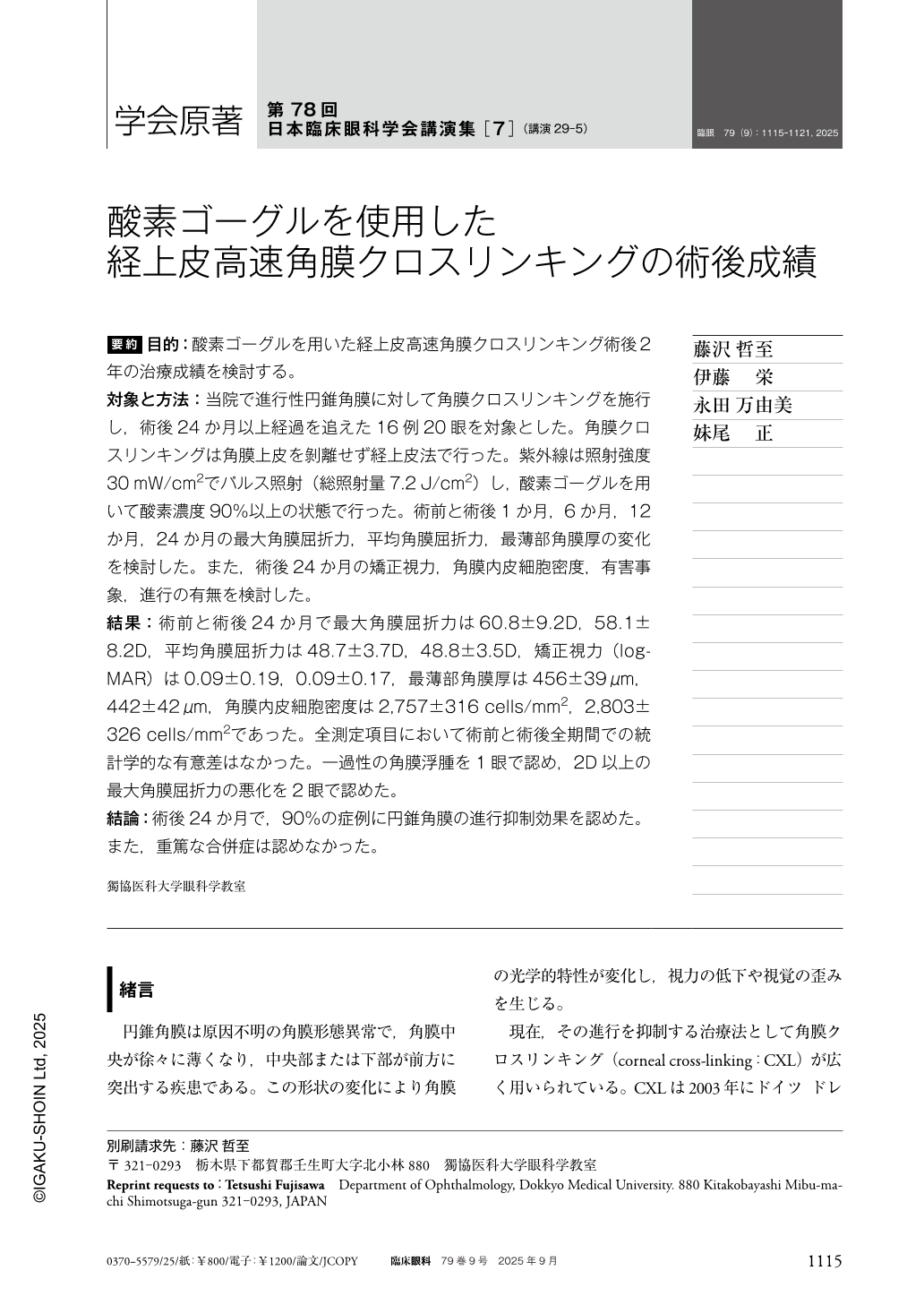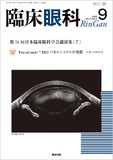Japanese
English
- 有料閲覧
- Abstract 文献概要
- 1ページ目 Look Inside
- 参考文献 Reference
要約 目的:酸素ゴーグルを用いた経上皮高速角膜クロスリンキング術後2年の治療成績を検討する。
対象と方法:当院で進行性円錐角膜に対して角膜クロスリンキングを施行し,術後24か月以上経過を追えた16例20眼を対象とした。角膜クロスリンキングは角膜上皮を剝離せず経上皮法で行った。紫外線は照射強度30mW/cm2でパルス照射(総照射量7.2J/cm2)し,酸素ゴーグルを用いて酸素濃度90%以上の状態で行った。術前と術後1か月,6か月,12か月,24か月の最大角膜屈折力,平均角膜屈折力,最薄部角膜厚の変化を検討した。また,術後24か月の矯正視力,角膜内皮細胞密度,有害事象,進行の有無を検討した。
結果:術前と術後24か月で最大角膜屈折力は60.8±9.2D,58.1±8.2D,平均角膜屈折力は48.7±3.7D,48.8±3.5D,矯正視力(logMAR)は0.09±0.19,0.09±0.17,最薄部角膜厚は456±39μm,442±42μm,角膜内皮細胞密度は2,757±316cells/mm2,2,803±326cells/mm2であった。全測定項目において術前と術後全期間での統計学的な有意差はなかった。一過性の角膜浮腫を1眼で認め,2D以上の最大角膜屈折力の悪化を2眼で認めた。
結論:術後24か月で,90%の症例に円錐角膜の進行抑制効果を認めた。また,重篤な合併症は認めなかった。
Abstract Purpose:To investigate the 2-year treatment outcomes of transepithelial high-velocity corneal cross-linking using oxygen goggles.
Subjects and methods:The study included 20 eyes(mean age 22.3 years, 12 men, 4 women) from 16 patients who underwent transepithelial high-velocity corneal cross-linking for progressive keratoconus at Dokkyo Medical University Hospital. All patients had undergone surgery more than 24 months prior. Corneal crosslinking was performed using the KXL system(Glaukos), and riboflavin was administered using Paracel(Glaukos). Ultraviolet radiation was delivered in pulses totaling 7.2 J/cm2 at an irradiation intensity of 30 mW/cm2, and oxygen goggles were used to maintain an oxygen concentration of 90% or higher. Changes in maximum corneal refractive power, mean corneal refractive power, and thinnest corneal thickness were evaluated before surgery and at 1, 6, 12, and 24 months postoperatively. Corrected visual acuity, corneal endothelial cell density, adverse events, and the presence or absence of disease progression were also assessed 24 months postoperatively.
Results:Before surgery and 24 months postoperatively, the maximum corneal refractive power was 60.8±9.2D and 58.1±8.2D, respectively;the mean corneal refractive power was 48.7±3.7D and 48.8±3.5D, respectively;the corrected visual acuity was logMAR 0.09±0.19 and 0.09±0.17, respectively;the thinnest corneal thickness was 456±39 μm and 442±42 μm, respectively;and the corneal endothelial cell density was 2757±316 cells/mm2 and 2803±326 cells/mm2, respectively. No statistically significant differences were observed in any of the measured parameters throughout the entire postoperative period. Transient corneal edema was observed in one eye as an adverse event. A deterioration of 2D or more in the maximum corneal refractive power was observed in one eye.
Conclusion:Transepithelial high-speed corneal cross-linking using oxygen goggles was effective in inhibiting the progression of keratoconus in 90% of cases 24 months postoperatively. No severe complications were observed.

Copyright © 2025, Igaku-Shoin Ltd. All rights reserved.


